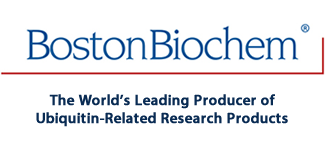
Recombinant Human Ubiquilin 1 Tandem UBA (TUBE2) Agarose, CF Summary
Ubiquilin 1 is a ubiquitously expressed member of the UBL-UBA family of Ubiquitin-binding proteins that is 589 amino acids (aa) in length and has a predicted molecular weight of 62.5 kDa (1). Human Ubiquilin 1 shares 88% aa sequence identity with the mouse and rat orthologs. It contains an N-terminal Ubiquitin-like (UBL) domain and a C-terminal Ubiquitin-associated (UBA) domain (2). The UBA domain is able to interact with mono- and poly-Ubiquitin chains, with a similar affinity for Lys48- and Lys63-linked chains (3,4). In contrast, the UBL domain interacts with Ubiquitin-interacting motif (UIM)-containing proteins, such as S5a/Angiocidin, a 19S Proteasome component (5). It is thought that Ubiquilin 1 may act as a molecular shuttle, bringing poly-ubiquitinated proteins to the 26S Proteasome by simultaneously binding poly-Ubiquitin via its UBA domain and the 19S Proteasome via its UBL domain (5). Ubiquilin 1 also binds two endoplasmic reticulum (ER)-localized proteins, Herp and Erasin, and may function in the ER-associated degradation pathway (6,7). It has been reported to co-precipitate with LC3/MAP1LC3A/Apg8p3, an autophagosomal marker, suggesting that it may play a role in autophagy (8,9). Single nucleotide polymorphisms in the UBQLN1 gene have been linked to Alzheimer"s disease (AD) (10). Furthermore, Ubiquilin 1 may regulate the processing of APP, which is associated with AD (11).
Tandem Ubiquitin Binding Entities (TUBEs) have been developed for the isolation and identification of ubiquitinated proteins. TUBEs display increased affinity for poly-Ubiquitin moieties over the single Ubiquitin binding associated domain (UBA). TUBEs also display a protective effect on poly-ubiquitinated proteins, allowing for detection at relatively low abundance. This affinity resin can be used for the enrichment, isolation and identification of K48-linked (preferentially) or K63-linked poly-Ubiquitin chains or ubiquitinated substrates that contain these linkages.
Specifications
- 3 months from date of receipt, 2 to 8 °C as supplied.
- 1 month, 2 to 8 °C under sterile conditions after opening.
Product Datasheets
Background: Ubiquilin 1
- Lee, D.Y. & E.J. Brown (2012) Biol. Chem. 393:441.
- Mah, A.L. et al. (2000) J. Cell Biol. 151:847.
- Raasi, S. et al. (2005) Nat. Struct. Mol. Biol. 12:708.
- Zhang, D. et al.(2008) J. Mol. Biol. 377:162.
- Ko, H.S. et al. (2004) FEBS Lett. 566:110.
- Kim, T.Y. et al. (2008) Biochem. Biophys. Res. Commun. 369:741.
- Lim, P.J. et al. (2009) J. Cell Biol. 187:201.
- N"Diaye, E.N. et al. (2009) EMBO Rep. 10:173.
- Rothenberg, C. et al. (2010) Hum. Mol. Genet. 19:3219.
- Bertram, L. et al. (2005) N. Engl. J. Med. 352:884.
- El Ayadi, A. et al. (2012) Proc. Natl. Acad. Sci. USA 109:13416.
Reagents Provided
Citations for Recombinant Human Ubiquilin 1 Tandem UBA (TUBE2) Agarose, CF
R&D Systems personnel manually curate a database that contains references using R&D Systems products.The data collected includes not only links to publications in PubMed,but also provides information about sample types, species, and experimental conditions.
4Citations: Showing 1 - 4Filter your results:
Filter by:
- DNA damage and transcription stress cause ATP-mediated redesign of metabolism and potentiation of anti-oxidant bufferingAuthors: C Milanese, CR Bombardier, S Sepe, S Barnhoorn, C Payán-Gomé, D Caruso, M Audano, S Pedretti, WP Vermeij, RMC Brandt, A Gyenis, MM Wamelink, AS de Wit, RC Janssens, R Leen, ABP van Kuilen, N Mitro, JHJ Hoeijmaker, PG MastroberaNat Commun, 2019;10(1):4887.2019
- Vms1 and ANKZF1 peptidyl-tRNA hydrolases release nascent chains from stalled ribosomesAuthors: R Verma, KM Reichermei, AM Burroughs, RS Oania, JM Reitsma, L Aravind, RJ DeshaiesNature, 2018;0(0):.2018
- p97/VCP promotes degradation of CRBN substrate glutamine synthetase and neosubstratesAuthors: TV Nguyen, J Li, CJ Lu, JL Mamrosh, G Lu, BE Cathers, RJ DeshaiesProc. Natl. Acad. Sci. U.S.A, 2017;0(0):.2017
- Capzimin is a potent and specific inhibitor of proteasome isopeptidase Rpn11Authors: J Li, T Yakushi, F Parlati, AL Mackinnon, C Perez, Y Ma, KP Carter, S Colayco, G Magnuson, B Brown, K Nguyen, S Vasile, E Suyama, LH Smith, E Sergienko, AB Pinkerton, TD Chung, AE Palmer, I Pass, S Hess, SM Cohen, RJ DeshaiesNat. Chem. Biol, 2017;0(0):.2017
FAQs
No product specific FAQs exist for this product, however you may
View all Proteins and Enzyme FAQsReviews for Recombinant Human Ubiquilin 1 Tandem UBA (TUBE2) Agarose, CF
Average Rating: 5(Based on 1 Review)
Have you used Recombinant Human Ubiquilin 1 Tandem UBA (TUBE2) Agarose, CF?
Submit a review and receive an Amazon gift card.
$25/€18/£15/$25CAN/¥75 Yuan/¥1250 Yen for a review with an image
$10/€7/£6/$10 CAD/¥70 Yuan/¥1110 Yen for a review without an image
Filter by:
Worked perfectly well for my project with C. elegans.

ebiomall.com






>
>
>
>
>
>
>
>
>
>
核酸是天然高分子化合物,,糖类中的多糖(淀粉、纤维素、糖原等)也是天然高分子化合物
同属于生命的六大营养物质(水,无机盐,糖类,脂质,核酸,蛋白质)
1.CA15-3属于多形上皮黏蛋白。CA15-3测定广泛用于乳腺癌的辅助诊断。60%~80%进展期乳腺癌患者的CA15-3浓度大30kU/L。CA15-3有助于判断肿瘤的进展和疗效,测定值大于1000kU/L者预后不良。在乳腺癌初期其灵敏度较低,在Ⅲ期时约为12%,因此CA15-3测定不能用作乳腺癌的筛选手段.当怀疑乳腺癌而CA15-3又正常时,可以结合CEA值进行考虑。应注意到治疗后由于肿瘤细胞死亡,CA15-3起初会升高,然后才逐渐下降。持续不降或上升者则提示病情恶化。
2.其他恶性肿瘤,如肺、结肠、胰腺、肝脏、卵巢癌、子宫颈和子宫内膜的恶性肿瘤也都可见到CA15-3不同程度的阳性率(低于10%)。
3.肝硬化、肝炎、结节病、结核病、自身免疫性疾病(SLE)以及卵巢、乳腺的良性病变中,CA15-3值略高于正常范围,但阳性率一般低于10%,妊娠中后期,有近一半孕妇血清CA15-3升高。
还有如果用气相做糖的鉴别的话,需要样品量大不大?怎么衍生化?
不好意思,我是学药分的,对植化比较外行,请详细些,谢了先!
一般情况下同时测定蔗糖、果糖和葡萄糖。
选用哪种检测器呐。
本来经战友的意见已决定用示差了,但突然有个经销商愿意以比较优惠的价格卖蒸发光给我们,所以又开始犹豫了。
最后一次请教各位战友,如题目。谢谢!!









